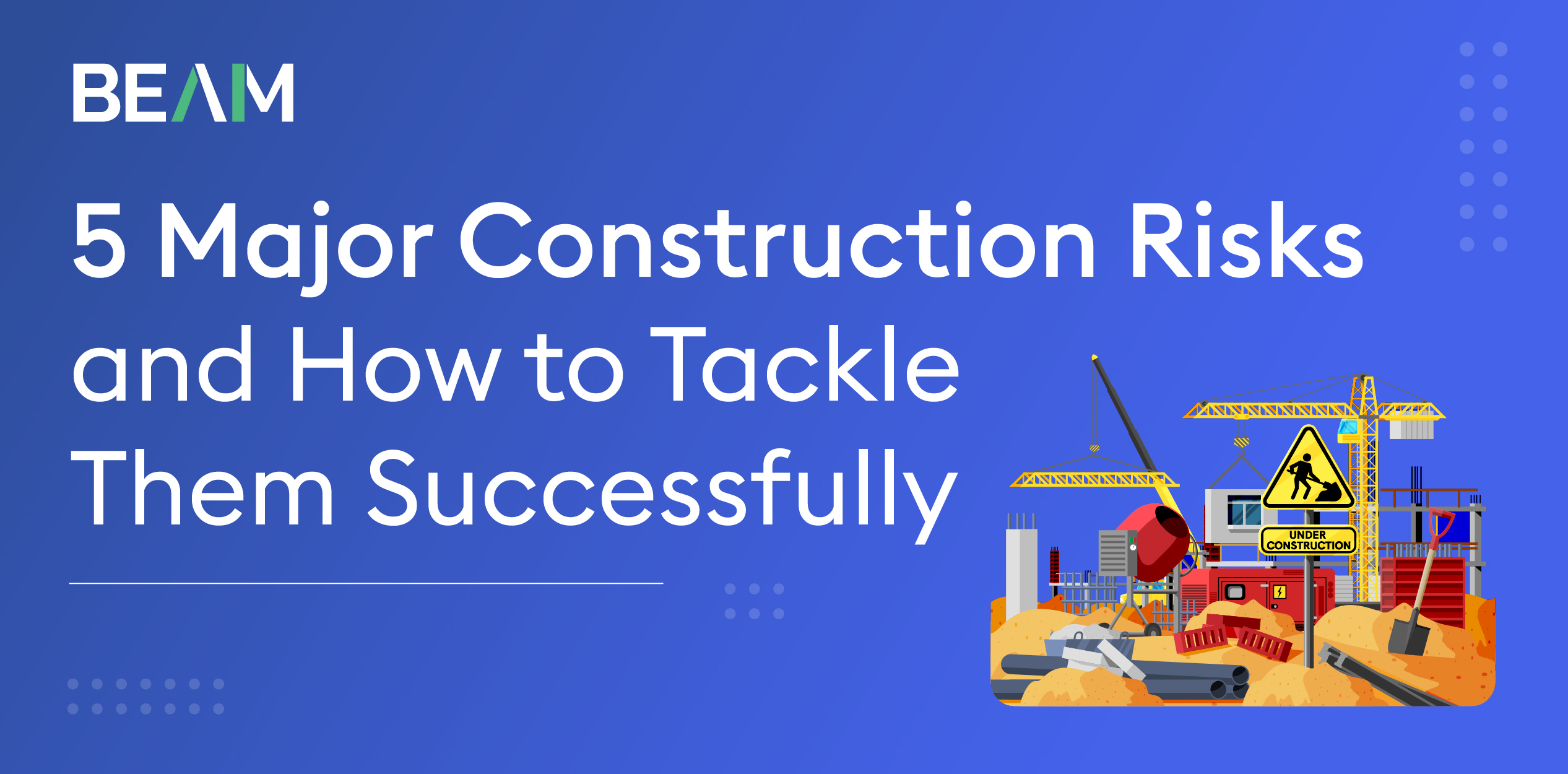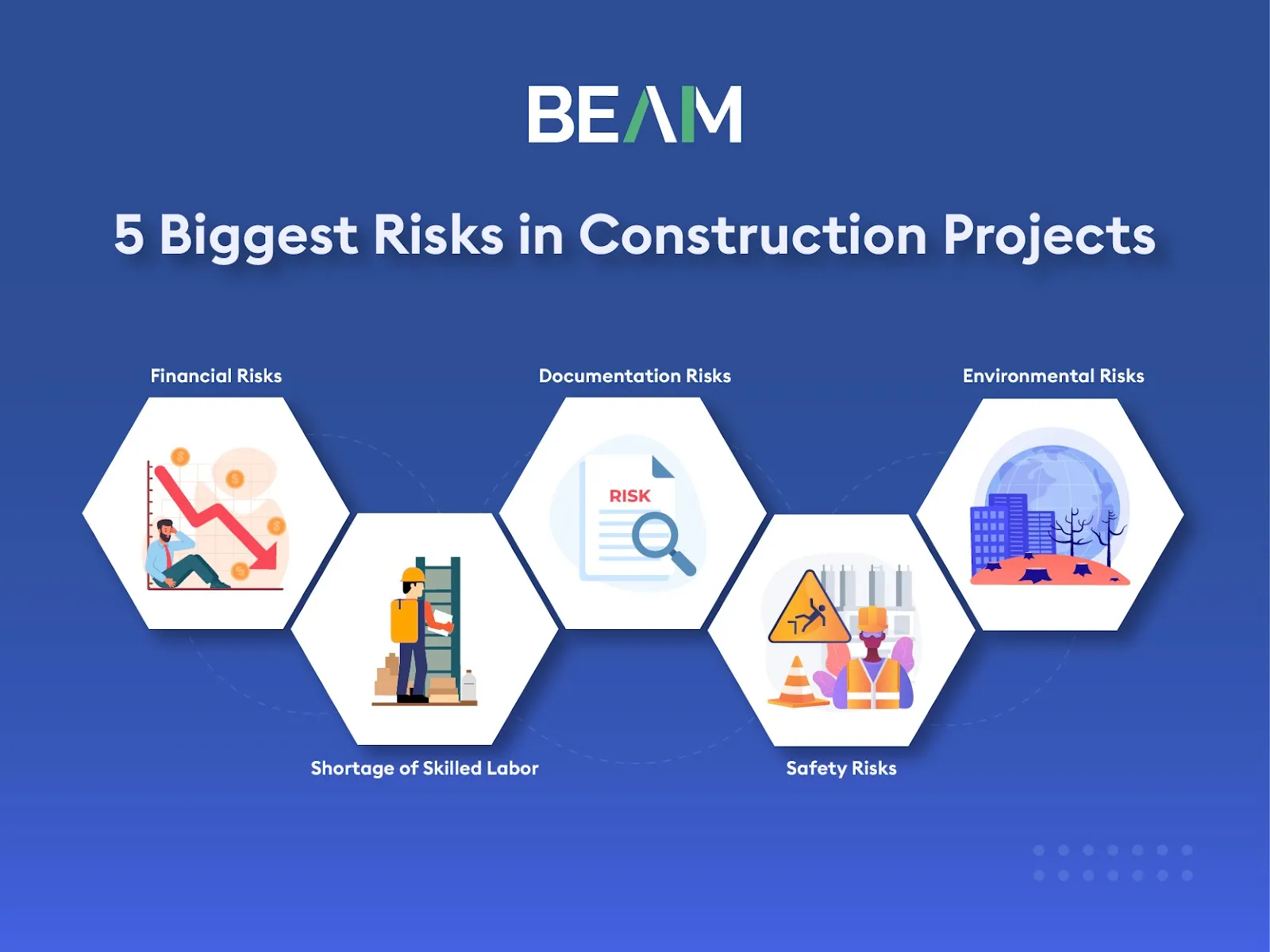5 Major Construction Risks and How to Tackle Them Successfully
Key Takeaways
- Over 70% of construction projects exceed budgets—strong construction risk management can drastically reduce this.
- Labor shortages and poor documentation are silent profit killers in most projects.
- AI-based takeoffs are game-changers for project risk mitigation.
- Effective safety and cost risk management starts with training, tech adoption, and compliance.
- Proactive planning beats crisis response—always plan for risks before breaking ground.

Summary:
What is Construction Risk Management?
Construction risk management is the process of identifying, assessing, and controlling potential risks that could derail a project’s cost, timeline, or safety. These risks-financial, operational, safety, or environmental-are often interconnected. A single weak link, like inaccurate estimates or labor delays, can ripple across the project.
By applying proactive project risk mitigation techniques, construction teams can maintain budgets, timelines, and client satisfaction without last-minute firefighting.
Top 5 Construction Risks and How to Mitigate Them

1. Financial Risks
One of the biggest challenges in construction is financial instability. A KPMG report shows that less than 33% of projects stay within 10% of their original budgets.
Common financial risks include:
- Budget overruns due to inaccurate takeoffs or unforeseen expenses
- Cash flow gaps leading to delayed payments or stalled progress
- Economic fluctuations causing price hikes in labor or materials
Project Risk Mitigation Tips:
- Accurate Budgeting: Use AI-powered takeoff tools like Beam AI for precise material estimation and cost control.
- Continuous Monitoring: Track spend in real-time using project management software to spot variances early.
- Cash Flow Planning: Secure financing and negotiate flexible payment schedules upfront.
- Market Contingency: Maintain a contingency fund to handle sudden cost or market shifts.
2. Shortage of Skilled Labor
The U.S. construction industry faces a serious workforce shortage-41% of the current workforce is set to retire by 2031.
Key risks include:
- Reduced labor productivity leading to longer project durations
- Compromised work quality due to inexperienced labor
- Scheduling delays as multiple projects compete for limited skilled workers
How to Mitigate Labor-Related Risks:
- Invest in Training: Partner with trade schools or apprenticeship programs to build a talent pipeline.
- Leverage Technology: Use automation, prefabrication, and digital workflows to boost productivity.
- Retain Workers: Offer career growth, recognition, and competitive benefits.
- Outsource Expertise: Subcontract specialized tasks to maintain quality and timelines.
3. Documentation Risks
Improper documentation can create a domino effect-legal disputes, delays, and regulatory violations.
Key documentation challenges:
- Ambiguities in contracts leading to disputes
- Non-compliance with safety or environmental regulations
- Permit delays due to incomplete applications
Risk Mitigation Strategies:
- Draft Clear Contracts: Engage legal experts to create precise, transparent agreements.
- Regular Compliance Audits: Verify adherence to local codes and safety standards before work begins.
- Efficient Permit Handling: Start early, maintain open communication with local authorities.
- Centralized Digital Systems: Use cloud-based platforms for document control and version tracking.
4. Safety Risks
Safety risks are the most visible and critical in construction risk management. OSHA identifies the “Fatal Four” hazards-falls, struck-by incidents, electrocutions, and caught-in/between accidents-as leading causes of fatalities.
Key safety and cost risks:
- Falls from scaffolds or roofs
- Struck-by incidents from moving vehicles or equipment
- Electrocutions due to unsafe electrical practices
- Caught-in/between accidents involving machinery or collapsing structures
How to Strengthen Jobsite Safety:
- Mandatory Safety Training: Conduct frequent role-specific safety sessions.
- Strict PPE Enforcement: Ensure every worker wears and maintains proper protective gear.
- Regular Safety Audits: Identify hazards proactively and fix them immediately.
- OSHA Compliance: Follow guidelines on fall protection, lockout/tagout, and safe equipment handling.
5. Environmental Risks
Environmental factors are unpredictable and often outside human control, yet they heavily impact project delivery.
Common environmental risks:
- Adverse weather delaying site work
- Unforeseen site conditions requiring redesigns or rework
- Evolving environmental laws leading to fines or shutdowns
Project Risk Mitigation Methods:
- Contingency Planning: Include buffers for weather delays and emergency response.
- Site Assessments: Conduct soil, environmental, and utility studies early.
- Sustainable Practices: Use eco-friendly materials, minimize waste, and design for energy efficiency.
- Compliance Monitoring: Perform regular environmental audits to stay ahead of changing regulations.
Building a Culture of Risk Awareness
Construction risk management isn’t just about responding to problems-it’s about preventing them. Encourage open communication about potential risks, adopt digital tools for tracking, and make risk awareness part of your company culture.
With proactive planning and smart project risk mitigation techniques, your team can minimize both safety and cost risks-delivering projects faster, safer, and within budget.
The Bottom Line
Construction projects will always involve uncertainty, but disciplined construction risk management makes all the difference. By using modern tools, fostering skilled teams, and enforcing compliance, contractors can turn risks into opportunities for innovation and competitive advantage.
Ready to future-proof your construction business?
Start exploring AI-powered takeoff tools like Beam AI to eliminate estimation errors and strengthen your preconstruction risk management process.
FAQs
1. What is construction risk management in simple terms?
It’s the process of identifying, evaluating, and controlling potential risks-financial, safety, or environmental-that could impact a construction project’s cost, schedule, or quality.
2. How does project risk mitigation improve profitability?
By anticipating risks early, teams can avoid costly rework, schedule delays, and safety violations-helping projects stay profitable and efficient.
3. What are common safety and cost risks in construction?
Common risks include worker injuries, material wastage, inaccurate cost estimation, and environmental non-compliance. Effective planning and safety audits can help prevent these.
4. How can technology improve construction risk management?
AI-based tools automate takeoffs, track budgets in real-time, and predict potential risks before they escalate-simplifying decision-making and reducing manual errors.


.png)





.png)
.png)
.png)

